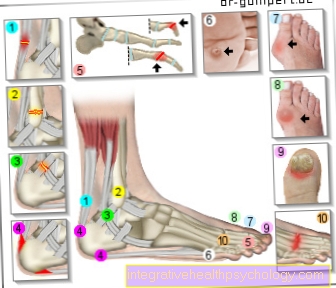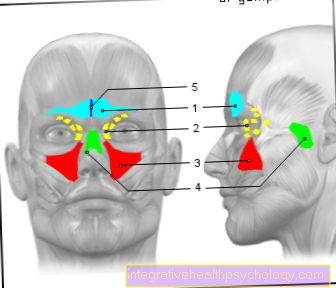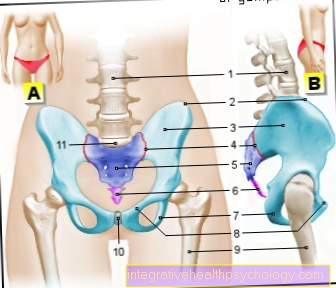Metatarsalgia
introduction

In the Metatarsalgia it is about Metatarsal pain taking only the pain in the area of the Metatarsal bones (Metacarpal bone) 2-5 included because pain in the area of the first metatarsal bone (Os metacarpalis I) are treated separately. Most metatarsal pain occurs during exercise, for example when running.
causes
The causes of primary metatarsalgia are mostly due to improper or overstrain, while secondary metatarsalgia is pain in the metatarsal caused by chronic diseases such as rheumatism or gout.
Furthermore, metatarsalgia can also be attributed to the wrong footwear. Women who like to wear high-heeled shoes or who force their feet into shoes that are too tight promote the malformation of the foot, which in turn can cause metatarsalgia.
Typical malformations of the foot are, for example, hallux valgus, hammer toe or claw toe. In addition, with age, the protective fat pad, which is physiologically located below the foot and thus cushions our steps, continues to disappear with increasing age (atrophied). This means that our metatarsus has to withstand greater stress. If there is an overload or an incorrect load due to incorrect footwear, this can lead to metatarsalgia.
Other causes can also be a so-called tendinitis, in which the tendons that pull to the bones of the foot are overloaded and become inflamed as a result and then sometimes cause severe pain.
Even if the ligaments are overloaded (Ligaments) in the metatarsalgia area.
More about this topic can be found: Tendonitis in the metatarsus
Extremely rarely, a soft tissue tumor in this area is to blame for the pain in the metatarsus area. On the other hand, metatarsalgia occurs more frequently after a fracture or a bruise in the metatarsal area. Since the pain then occurs after the actual trauma (here the break), one speaks of one post-traumatic metatarsalgia.
In extremely rare cases, aseptic bone necrosis (Köhler's disease type II), a bone tumor or chronic periostitis may be the cause of the metatarsalgia.
If you already have a chronic disease, such as osteoarthritis, the aforementioned secondary metatarsalgia can occur. The actual disease (here, for example, osteoarthritis) spreads to other areas of the body, in the case of the metatarsal this then leads to metatarsalgia.
In general, however, the most common cause of metatarsalgia is the wrong footwear and the resulting misalignment of the metatarsus.
diagnosis
To the Diagnosis of metatarsalgia In order to be able to provide a detailed information is required Doctor-patient conversation (anamnese), which includes the Footwear and related Postures of the foot but also any previous illnessessuch as a arthrosis or a previous one Fracture in the metatarsal area must be asked.
The inspectionSo looking at the feet can be helpful as the doctor may Deformities can recognize, but the actual finding of the metatarsalgia cannot be made in this way. It is therefore important that the doctor also palpates the foot (Palpation). Here you can increase Calluses in the area of the metatarsus, in addition it can be that by the Pressure with your fingers on the metatarsus, which provokes pain in patients. In most patients, palpation can also be used to determine that the protective fat pads is narrower below the foot than would physiologically be the case.
Using these three investigation methods- anamnese, inspection and Palpation, can usually very reliably be concluded that there is a metatarsalgia. However, the doctor may also need one X-ray image of the foot, especially if there is a suspicion of a fracture in the metatarsal area, which then triggered the metatarsalgia. Further diagnostic measures are not necessary.
Appointment with ?

I would be happy to advise you!
Who am I?
My name is dr. Nicolas Gumpert. I am a specialist in orthopedics and the founder of .
Various television programs and print media report regularly about my work. On HR television you can see me every 6 weeks live on "Hallo Hessen".
But now enough is indicated ;-)
Athletes (joggers, soccer players, etc.) are particularly often affected by diseases of the foot. In some cases, the cause of the foot discomfort cannot be identified at first.
Therefore, the treatment of the foot (e.g. Achilles tendonitis, heel spurs, etc.) requires a lot of experience.
I focus on a wide variety of foot diseases.
The aim of every treatment is treatment without surgery with a complete recovery of performance.
Which therapy achieves the best results in the long term can only be determined after looking at all of the information (Examination, X-ray, ultrasound, MRI, etc.) be assessed.
You can find me in:
- Lumedis - your orthopedic surgeon
Kaiserstrasse 14
60311 Frankfurt am Main
Directly to the online appointment arrangement
Unfortunately, it is currently only possible to make an appointment with private health insurers. I hope for your understanding!
Further information about myself can be found at Dr. Nicolas Gumpert
Figure pain ankle

Foot pain
- Achilles tendonitis /
Achilles tendon rupture - Broken bones - toes,
Metatarsus, tarsus
(here outer ankle fracture) - Ligament stretch / torn ligament
at the ankle - Lower and upper heel spurs
Calcaneus spur - Hammer toe and claw toe
(Deformities of the toe bones)
Digitus malleus - Plantar warts
Verrucae plantares - Hallux valgus -
(Deviation of the big toe
in the base joint) - Hallux rigidus -
(Joint wear of the
Metatarsophalangeal joint) - Inflamed nails / nail fungus
- Osteoarthritis / arthritis -
degenerative change of
Joints / inflammation of the joints
You can find an overview of all Dr-Gumpert images at: medical illustrations
Symptoms
With metatarsalgia, the patient complains Metatarsal painthat get worse, especially with exercise. In addition to the stress-related pain, there is usually also one increased callus formation in the metatarsal area, which the patient may find uncomfortable or annoying.
Further Symptoms are rare in metatarsalgia, unless it is a secondary metatarsalgia caused by a previous one arthrosis or gout has arisen, then the symptoms of osteoarthritis or gout also come.
In the case of metatarsalgia caused by a Break In addition, it may be in the metatarsal area too Swelling and Redness, possibly too Bruising, comes, whereby the bruises change color over time and then appear more yellowish-greenish.
therapy

In the therapy on the one hand it is important that To alleviate the patient's symptoms, for another, it is important in the future to avoid a renewed outbreak of metatarsalgia.
This is why it is absolutely advisable that the patient first consider himself suitable footwear and do without high heels and shoes that are too tight. With this method alone, patients can be helped in many cases and the foot recovers "by itself", in which insolesthat are precisely adapted to the shape of the foot can also have a supportive effect.
Since the patient usually still complains of pain in the early stages even though he is already wearing suitable footwear, it can help at the beginning local pain relievers to use in order to prevent a wrong gait caused by the pain.
The patient can either remove the aesthetically disturbing calluses himself or with the help of a professional foot care remove.
At a fracture however, the patient may have to undergo additional surgery in order to achieve optimal healing.
In the case of metatarsalgia that is already well advanced, it may also be that an operation is necessary in which the Midbones are shortened and the heads of the metatarsals are thus drawn further back. This changes the shape of the foot as well as its size surgery however, in rare cases it can itself be a trigger for metatarsalgia, so it is particularly important to to go to the doctor on time and to pay attention to suitable footwear.
prophylaxis
To a Metatarsalgia to prevent, it makes sense to suitable footwear to pay attention. That means the shoe is a the best possible and resilient sole should have, with regular exercise insoles can be used, which optimally adapt to the shape of the foot. With women it is especially important that they wear tall ones High heels or from Sandals Avoid or minimize as much as possible without a sole profile.
forecast
The forecast metatarsalgia is usually very good. Metatarsalgia is common wrong footwear and the resulting incorrect loading of the foot is indicated and can thus be easily eliminated by changing the shoes.
However, if the metatarsalgia is more advanced and therefore a surgery If necessary, problems arise more often, it can even lead to one renewed onset of pain come due to the change in the foot due to the operation. In this case, the prognosis is still good, but not as good as if only conservative therapy is necessary.





























